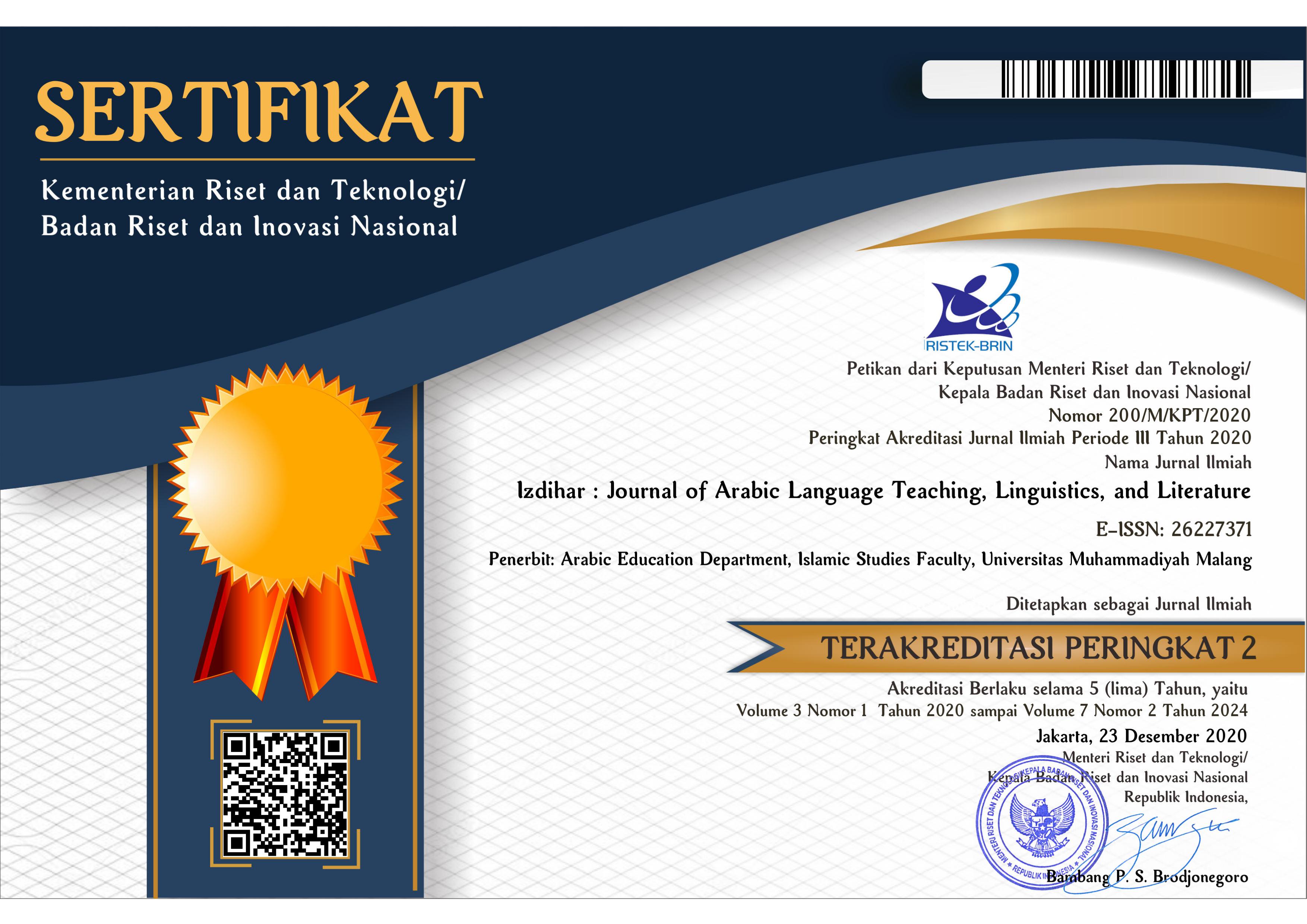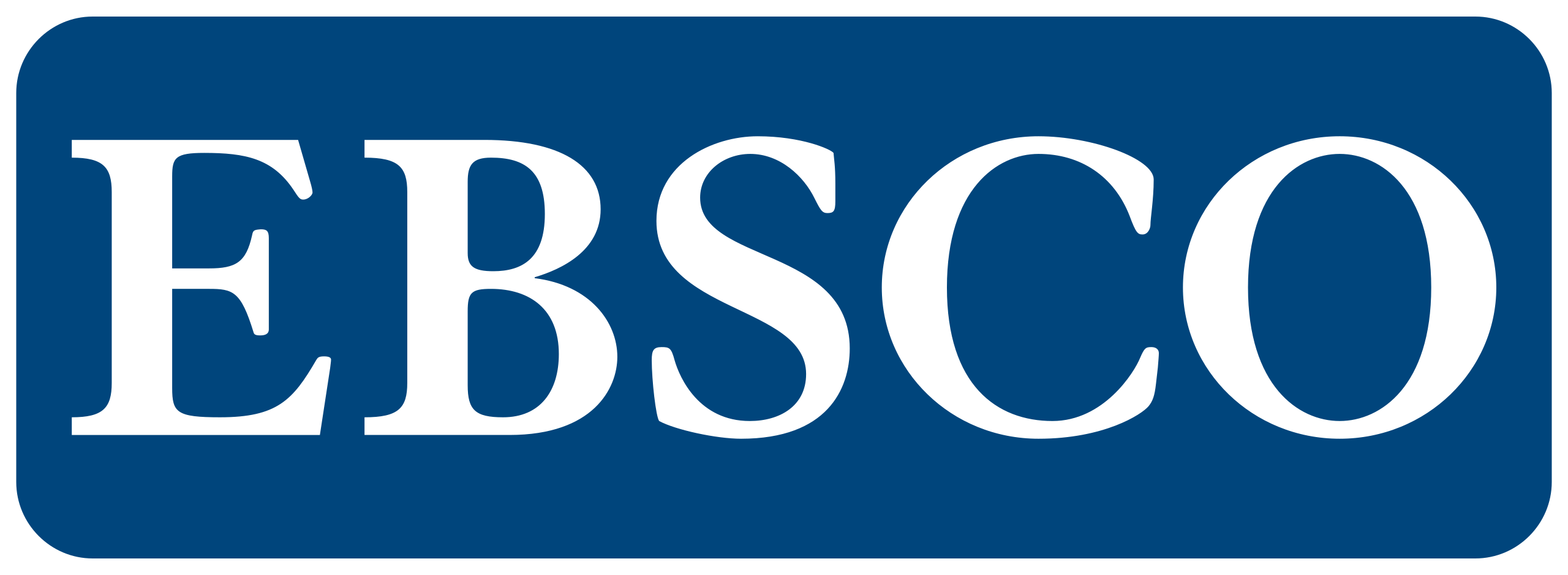Improving Quality of Arabic Translation Course through Jigsaw Cooperative Learning
DOI:
https://doi.org/10.22219/jiz.v3i1.11033Keywords:
Arabic Translation, Jigsaw, Terjemah Arab-Indonesia Course, Translation QualityAbstract
Translation is not only a process of language transfer, but also a transfer of culture from the source language to the target language. For this reason, translators must have broad and rich insights. The process to enrich cultural insights, knowledge, and treasures in the translation process can be formed through Jigsaw Cooperative Learning model because it is student-centered learning and requires them to independently seek and share knowledge. This study aimed to improve the ethos of students learning in Arabic translation subject and to improve students’ Arabic translation quality. This classroom action research was conducted two cycles (repeated seven times). Each cycle referred to Spiral Model by Kemmis, McTaggart, and Nixon. The subjects were 52 students of C Class and D Class in Terjemah Arab-Indonesia Course at Arabic Language and Literature Department of UIN Sunan Kalijaga Yogyakarta. The data of students’ learning ethos were obtained from performance grading rubric in Jigsaw Cooperative Learning and the data of Arabic translation quality were obtained from students worksheet assesment and end-of-cycle Arabic translation test. The results showed that Jigsaw Cooperative Learning improved (1) the learning ethos, especially the independence of students in seeking and sharing knowledge through Jigsaw Cooperative Learning and (2) the quality of Arabic-Indonesia translation. This model was effectively used for this course because students can translate longer texts with relatively short time.
Downloads
References
Ariyanti, M. L., & Tanjung, S. (2019). Hubungan Kompetensi Penerjemah dan Kualitas Terjemahan. Jurnal Ilmiah Bina Bahasa, 12(1), 21–30. DOI: https://doi.org/10.33557/binabahasa.v12i1.206
Asrori, I. (2016). Mengadopsi Teori Medan Makna Menjadi Metode Pengajaran Bahasa Arab di Era Posmetode. Prosiding Konfererensi Nasional Bahasa Arab, 1(2). http://prosiding.arab-um.com/index.php/konasbara/article/view/44/0
Baharudin, H. (2017). Strategi dan Teknik Terjemahan Novel Arab dalam Kalangan Pelajar Universiti (Arabic Novel Translation Strategies and Techniques used among University Students). GEMA Online® Journal of Language Studies, 17(4), 225-243. DOI: http://dx.doi.org/10.17576/gema-2017-1704-15
Baloche, L., & Brody, C. M. (2017). Cooperative Learning: Exploring Challenges, Crafting Innovations. 43(3), 274–283. DOI: https://doi.org/10.1080/02607476.2017.1319513
Barr, C. D., Uccelli, P., & Galloway, E. P. (2019). Specifying the Academic Language Skills that Support Text Understanding in The Middle Grades: The Design and Validation of the Core Academic Language Skills Construct and Instrument. Language Learning, 69(4), 978–1021. DOI: https://doi.org/10.1111/lang.12365
Berger, R., & Hänze, M. (2015). Impact of expert teaching quality on novice academic performance in the jigsaw cooperative learning method. International Journal of Science Education, 37(2), 294–320. DOI: https://doi.org/10.1080/09500693.2014.985757
Caplan, N. A. (2019). Learning through Language: A Response to Polio,“Keeping the Language in Second Language Classes.” Journal of Second Language Writing, 46, 100676-100677. DOI: https://doi.org/10.1016/j.jslw.2019.100677
Dickins, J., Hervey, S., & Higgins, I. (2016). Thinking Arabic Translation: A Course in Translation Method: Arabic to English. Taylor & Francis.
Fahrurrozi, A. (2014). Pembelajaran Bahasa Arab: Problematika dan Solusinya. Arabiyat: Jurnal Pendidikan Bahasa Arab Dan Kebahasaaraban, 1(2), 161–180. DOI: https://doi.org/10.15408/a.v1i2.1137
Fauzi, M. F., Buhun, M. F., & Purwadi, A. (2019). The Influence of Teams Games Tournament (TGT) toward Students’ Interest in Arabic Language Learning. Izdihar: Journal of Arabic Language Teaching, Linguistics, and Literature, 2(2), 135–148. DOI: https://doi.org/10.22219/jiz.v2i2.9986
Feng, Y., & Webb, S. (2019). Learning Vocabulary Through Reading, Listening, and Viewing: Which Mode of Input is Most Effective? Studies in Second Language Acquisition, 1–25. DOI: https://doi.org/10.1017/S0272263119000494
Habibullah, M. (2015). Proses dan Hasil Penerjemahan Mahasiswa (Studi Kasus Pada Mahasiswa Translation Theory and Practice Di STAIN Pamekasan). NUANSA: Jurnal Penelitian Ilmu Sosial dan Keagamaan Islam, 12(1), 207–232. DOI: http://dx.doi.org/10.19105/nuansa.v12i1.703
Harahap, K. A. (2014). Analisis Kesalahan Linguistik Hasil Terjemahan Mesin Terjemah Google Translate dari Teks Bahasa Arab ke dalam Bahasa Indonesia. Jurnal Penelitian Agama, 15(1), 26–43. DOI: https://doi.org/10.24090/JPA.V15I1.2014.PP26-43
Hidayatullah, M. S. (2017). Jembatan Kata: Seluk Beluk Penerjemahan Arab-Indonesia. Jakarta: Gramedia Widiasarana.
Karacop, A., & Diken, E. H. (2017). The Effects of Jigsaw Technique Based on Cooperative Learning on Prospective Science Teachers’ Science Process Skill. Journal of Education and Practice, 8(6), 86–97. Call Number: EJ1133003
Karacop, A., & Doymus, K. (2013). Effects of jigsaw cooperative learning and animation techniques on students’ understanding of chemical bonding and their conceptions of the particulate nature of matter. Journal of Science Education and Technology, 22(2), 186–203. DOI: https://doi.org/10.1007/s10956-012-9385-9
Kemmis, S., McTaggart, R., & Nixon, R. (2014). Introducing Critical Participatory Action Research. Dalam The Action Research Planner (pp. 1–31). Springer.
Khoshsima, H., & Saed, A. (2016). Task-Based Instruction and Vocabulary Learning: A Comparative Study of Jigsaw and Information Gap Tasks on Vocabulary Learning. International Journal of Applied Linguistics and English Literature, 5(5), 228–236. DOI: http://dx.doi.org/10.7575/aiac.ijalel.v.5n.5p.228
Mahbubah, L., Biahmada, A. M. M., & Mauludiyah, L. (2020). Learning Arabic Translation at Islamic Boarding School in Madura. Izdihar: Journal of Arabic Language Teaching, Linguistics, and Literature, 2(3), 231–242. DOI: https://doi.org/10.22219/jiz.v2i3.10578
Miles, Huberman, A. M., & Saldana, J. (2014). Qualitative Data Analysis: Methodes Sourcebook (Third Edit). Singapore: Sage.
Munthe, B. (2016). Strategi Mengajar Aktif, Kreatif, Inovatif (Second Edition). Yogyakarta: mSuka Press.
Nikmah, K. (2019). Meaning Variations of Qāla (قال) in Indonesian Language. Izdihar: Journal of Arabic Language Teaching, Linguistics, and Literature, 2(2), 77–100. DOI: https://doi.org/10.15408/bat.v25i1.11506
Nurbayan, Y. (2014). Pengaruh Struktur Bahasa Arab terhadap Bahasa Indonesia dalam Terjemahan Al-Qurʼan. Arabiyat: Jurnal Pendidikan Bahasa Arab dan Kebahasaaraban, 1(1), 21–28. DOI: https://doi.org/10.15408/a.v1i1.1128
Pellicer-Sánchez, A. (2016). Incidental L2 Vocabulary Acquisition from and while Reading: An Eye-Tracking Study. Studies in Second Language Acquisition, 38(1), 97–130. DOI: https://doi.org/10.1017/S0272263115000224
Perdana, D. H. (2017). Strategi Penerjemahan Bahasa Arab yang Berterima dan Mudah Dipahami. Jurnal Bahasa Lingua Scientia, 9(1), 143–160. DOI: https://doi.org/10.21274/ls.2017.9.1.143-160
Qabbani, N. (1970). Kitab al-Hubb. Cairo: Mansyurat Nizar Qabbani.
Sari, R. R. (2018). The Use of Keyword and Imagery Mnemonic for Vocabularies Learning for AFL Students. Izdihar: Journal of Arabic Language Teaching, Linguistics, and Literature, 1(2), 129–136. DOI: https://doi.org/10.22219/izdihar.v1i2.7294
Somadayo, S. (2013). Penelitian Tindakan Kelas. Yogyakarta: Graha Ilmu.
Wahyono, S. B., Hardianto, D., & Miyarso, E. (2014). Pengukuran Indeks Etos Belajar Siswa di Daerah Istimewa Yogyakarta. Jurnal Kependidikan: Penelitian Inovasi Pembelajaran, 44(1), 51-63. DOI: https://doi.org/10.21831/jk.v44i1.2191
Wicaksono, A., & Roza, A. S. (2015). Teori Pembelajaran Bahasa: Suatu Catatan Singkat. Yogyakarta: Penerbit Garudhawaca.
Yamada, M., Goda, Y., Hata, K., Matsukawa, H., & Yasunami, S. (2016). Flip-J: Development of the System for Flipped Jigsaw Supported Language Learning. Research-publishing. net, 490–495. DOI: https://doi.org/10.14705/rpnet.2016.eurocall2016.612
Yuliasri, I. (2014). Cooperative Learning Techniques to Improve Students’ Translation. Language Circle: Journal of Language and Literature, 8(2), 107–114. DOI: https://doi.org/10.15294/lc.v8i2.3015
Downloads
Published
How to Cite
Issue
Section
License
Copyright Notice
Authors who publish with this journal agree to the following terms:
- Authors retain copyright and grant the journal right of first publication with the work simultaneously licensed under a Creative Commons Attribution-ShareAlike 4.0 International License that allows others to share the work with an acknowledgment of the work's authorship and initial publication in this journal.
- Authors are able to enter into separate, additional contractual arrangements for the non-exclusive distribution of the journal's published version of the work (e.g., post it to an institutional repository or publish it in a book), with an acknowledgment of its initial publication in this journal.
- Authors are permitted and encouraged to post their work online (e.g., in institutional repositories or on their website) prior to and during the submission process, as it can lead to productive exchanges, as well as earlier and greater citation of published work (See The Effect of Open Access).
Copyright (c) 2019 Izdihar : Journal of Arabic Language Teaching, Linguistics, and Literature

This work is licensed under a Creative Commons Attribution-ShareAlike 4.0 International License.

















